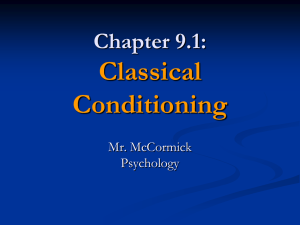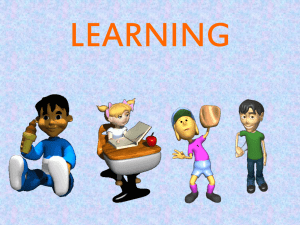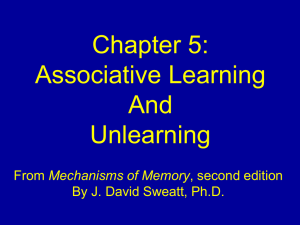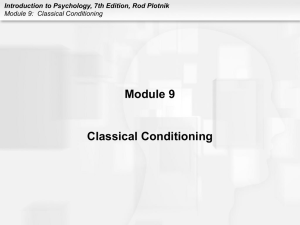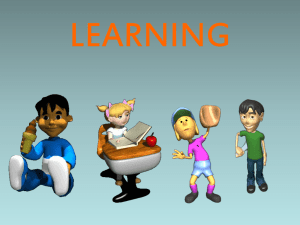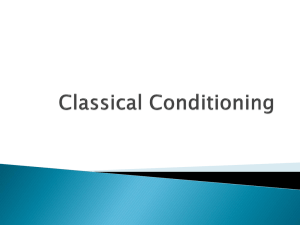Introduction to Psychology, 7th Edition, Rod Plotnik Module 9
advertisement
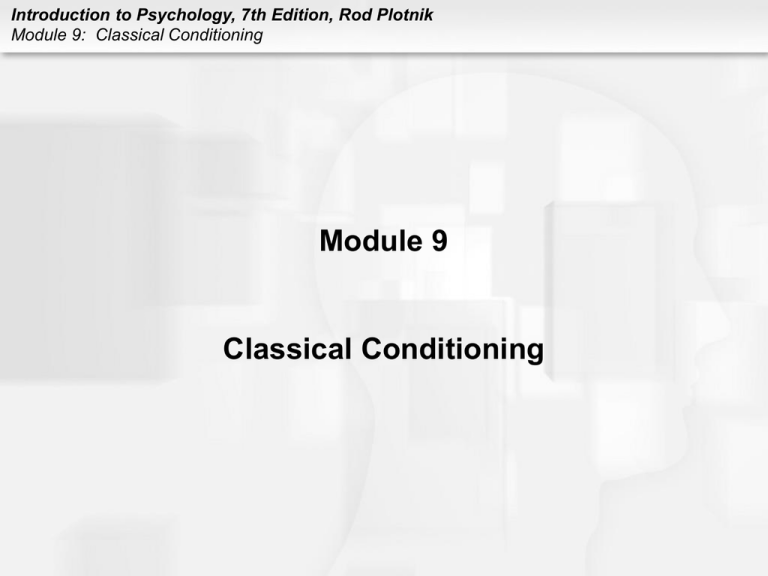
Introduction to Psychology, 7th Edition, Rod Plotnik Module 9: Classical Conditioning Module 9 Classical Conditioning Introduction to Psychology, 7th Edition, Rod Plotnik Module 9: Classical Conditioning THREE KINDS OF LEARNING Classical conditioning • Stimulus substitution • Pavlov/dogs Operant conditioning • Consequences • Thorndike/cats • Skinner/rats Cognitive learning • Predictable relationships • Bandura/Bobo doll Introduction to Psychology, 7th Edition, Rod Plotnik Module 9: Classical Conditioning Classical Conditioning • Classical conditioning – stimulus substitution/conditioned reflex – Involuntary/elicited response – The goal is to create a new response to a neutral stimulus – Ex. The sight of a needle can trigger fear – Helps predict what may happen (survival) • Ivan Pavlov (salivating dogs) – Pavlov rang a bell before putting food in a dogs mouth. – after numerous trials of pairing the food and bell, the dog salivated to the sound of the bell – This becomes a conditioned reflex Introduction to Psychology, 7th Edition, Rod Plotnik Module 9: Classical Conditioning Theories of classical conditioning Stimulus substitution – a neural bond or association forms in the brain between the neutral stimulus (bell) and unconditioned stimulus (food) – The bell substitutes for food Contiguity theory • two stimuli (neutral stimulus and unconditional stimulus) are paired close together in time (contiguous) • The sight of food elicits salivation Introduction to Psychology, 7th Edition, Rod Plotnik Module 9: Classical Conditioning Theories of classical conditioning (cont.) Cognitive perspective • an organism learns a predictable relationship between two stimuli such that the occurrence of one stimulus (neutral stimulus) predicts the occurrence of another (unconditioned stimulus) – The bell predicts the food Introduction to Psychology, 7th Edition, Rod Plotnik Module 9: Classical Conditioning Classical Conditioning NS UCS CS UCR CR Introduction to Psychology, 7th Edition, Rod Plotnik Module 9: Classical Conditioning PROCEDURE: CLASSICAL CONDITIONING • Step 1: Choosing stimulus and response – Neutral stimulus • some stimulus that causes a sensory response, such as being seen, heard, or smelled, but does not produce the reflex being tested – Unconditioned stimulus • USC, some stimulus that triggers or elicits a physiological reflex, such as salivation or eye blink – Unconditioned response • UCR, unlearned, innate, involuntary physiological reflex that is elicited by the unconditioned stimulus Introduction to Psychology, 7th Edition, Rod Plotnik Module 9: Classical Conditioning PROCEDURE: CLASSICAL CONDITIONING (CONT.) • Step 2: Establishing classical conditioning – Neutral stimulus • trial, pair neutral stimulus (bell) with the unconditioned stimulus (food) • neutral stimulus presented first then short time later the unconditioned stimulus – Unconditioned stimulus • seconds after the tone begins, you present the UCS – Unconditioned response • UCS (food) elicits the UCR (salivation) Introduction to Psychology, 7th Edition, Rod Plotnik Module 9: Classical Conditioning PROCEDURE: CLASSICAL CONDITIONING (CONT.) • Step 3: Testing for conditioning – Conditioned stimulus • CS, is a formerly neutral stimulus that has acquired the ability to elicit a response that was previously elicited by the unconditioned stimulus – Conditioned response • CR, elicited by the conditioned stimulus, is similar to, but not identical in size or amount to, the UCS • CR, less salivation than the UCR Introduction to Psychology, 7th Edition, Rod Plotnik Module 9: Classical Conditioning OTHER CONDITIONING CONCEPTS • Generalization – tendency for a stimulus that is similar to the original CS to elicit a response that is similar to the CR – Shampoo and aftershave • Discrimination – occurs during classical conditioning when an organism learns to make a particular response to some stimuli but not to others – Nail polish and aftershave Introduction to Psychology, 7th Edition, Rod Plotnik Module 9: Classical Conditioning OTHER CONDITIONING CONCEPTS (CONT.) • Extinction – a CS is repeatedly presented without the UCS and, as a result, the CS tends to no longer elicit the CR – Boyfriend’s aftershave • Spontaneous recovery – tendency for the CR to reappear after being extinguished even though there have been no further conditioning trials • Systematic Desensitization – Change CS back to NS – Effective tx for nausea, fear of blood, public speaking Introduction to Psychology, 7th Edition, Rod Plotnik Module 9: Classical Conditioning ADAPTIVE VALUES & USES • Adaptive value – certain abilities or genetic traits that have evolved to increase survival, such as finding food, acquiring mates, and avoiding pain and injury – Bluejays avoid Monarchs • Taste aversion learning – associating a particular sensory cue (smell, tastes, sound, or sight) with getting sick and thereafter avoiding that particular unpleasant or dangerous sensory cue in the future – Can develop after one exposure and last 4-5 years Introduction to Psychology, 7th Edition, Rod Plotnik Module 9: Classical Conditioning Classical Conditioning NS Bell Aftershave UCS UCR Loud noise, chemo, food, dental procedure, needle injection Tapping arm Salivation Nausea Anxiety Sight of needle Pain Fear Dish soap Rat/rabbit/ dog Eye blink CS Noise of squeaky wheelbarrow, aftershave CR Salivating to the sound of a bell or wheelbarrow, fear/fainting/nausea Startle Cry

